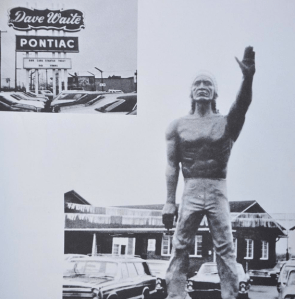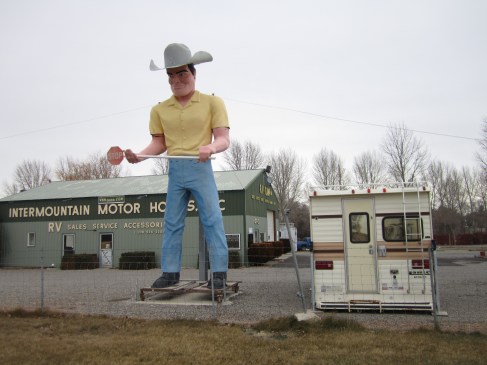
Muffler Men are giant, hollow fiberglass statues which were built from 1963-1972. They were about 22 feet tall, depending on the model. The statues were produced in Venice, CA by International Fiberglass which simply called them Giant Men.

Roadside America team in the early 90s inspecting a Muffler Man in Milford, NB
The Muffler Man name wasn’t coined until the 1990s. The founders of RoadsideAmerica.com began cataloguing offbeat attractions around the U.S. in the mid-1980s for their first book, “Roadside America.” The trio, Doug Kirby, Ken Smith, Mike Wilkins, began to notice the similarities between many of the statues. There were more of them around back then and the trio lost no time documenting the giants. By the 1992 release of their second book, “New Roadside America,” they had about 12 of these statues in their database. While they were amused by the statues, they did not make a big deal about them. Amongst themselves they began calling them “Muffler Men” since a few of the statues they’d seen held mufflers.
 In 1996, when Kirby, Smith, and Wilkins launched the website, RoadsideAmerica.com, they included a section called “The Secret Plot of the Muffler Men.” Sightings and photos of these statues began pouring in from the website’s visitors. A map and on-line database were created at to help document these statues around the country. The website continues to this day, to receive tips about new Muffler Man discoveries and updates from visitors each month. While it is rare that a undocumented statue is found, a new one still seems to pop up every year or so that no one seems to have known about.
In 1996, when Kirby, Smith, and Wilkins launched the website, RoadsideAmerica.com, they included a section called “The Secret Plot of the Muffler Men.” Sightings and photos of these statues began pouring in from the website’s visitors. A map and on-line database were created at to help document these statues around the country. The website continues to this day, to receive tips about new Muffler Man discoveries and updates from visitors each month. While it is rare that a undocumented statue is found, a new one still seems to pop up every year or so that no one seems to have known about.

Bob Prewitt with one of his creations
The first Muffler Man statue was created by Bob Prewitt in Lawndale, CA. His business, Prewitt Fiberglass Animals, produced many of the giant chickens, pigs, buffalo, horses, and other animals still seen around the country today. Around 1962, Prewitt got an order from someone in Sacramento, CA for a 20 foot tall Paul Bunyan statue. Prewitt hired an artist named Bill Swan to sculpt a 20 ft Paul Bunyan statue holding an axe. Months were spent working on the design and finally the product stood towering over the fiberglass yard in Lawndale. The first Muffler Man had been made. However, the guy who ordered it never paid for it so Bob hit the road with the statue on a flatbed trailer. Supposedly, he headed east on Route 66 and went looking for a buyer. He happened upon the Lumberjack Café in Flagstaff, AZ and sold the statue to them. When he got back to California Prewitt used a mold of the Bunyan to make more and found that they were good sellers.
In October of 1963, Prewitt sold the manufacturing interest of his company West Coast Industries Inc, the parent company of International Fiberglass. Stanley Dashew brokered the deal for his son Steve who was young and running a fiberglass boat business. Since he was already skilled with fiberglass, he thought producing some statues might be a good way to boost sales during the slow months.

A indian stands at a Pontiac dealership
A family friend of the Dashew family named Violet Winslow joined the team shortly after the purchase from Prewitt. She worked in the office and helped with promotion. Up to that point they were were selling a few figures here and there, one of which went to an American Oil gas station in Las Vegas. Violet got a story published in “National Petroleum News” about this installation in which the owner indicated his sales had doubled after installing his Bunyan. After that, Dashew refers to the next few years as the “invasion”. Quickly, International Fiberglass modified the Bunyan mold to produce Cowboys for Phillips 66 stations, Indians for Mohawk stations and Pontiac dealerships, and Vikings for Viking Carpets. The company also produced Uncle Sams, Pioneers, Pirates, Alfred E. Neumann look-alikes, as well as other customized statues. International Fiberglass also produced a giant female statue for Uniroyal Tires.
Things continued for about 6 years before advertising started moving in other directions and the fiberglass craze of the 1960s ended. By the time the company folded in 1972, there were hundreds of these statues on display across the country. Today, there are about 196 original Muffler Men left altogether. While it is believe that all of the original molds were destroyed, new molds have been created to replace damaged body parts and create new giants.
 The very first Muffler Man produced is still in Flagstaff. It now stands outside the J. Lawrence Walkup Skydome at Northern Arizona University. That statue was built in one piece. The other Paul Bunyan statue at NAU also came from the Lumberjack Cafe. The restaurant bought that one just a few years after the first one. By then, the statues were produced in four pieces which bolted together. At some point, International Fiberglass changed the way that the statues’ arms fit into the shirt sleeves. Many of the earliest statues are still located in the Los Angeles area.
The very first Muffler Man produced is still in Flagstaff. It now stands outside the J. Lawrence Walkup Skydome at Northern Arizona University. That statue was built in one piece. The other Paul Bunyan statue at NAU also came from the Lumberjack Cafe. The restaurant bought that one just a few years after the first one. By then, the statues were produced in four pieces which bolted together. At some point, International Fiberglass changed the way that the statues’ arms fit into the shirt sleeves. Many of the earliest statues are still located in the Los Angeles area.
I want to thank Gabriel Aldaz, the author of Right Palm Up, Left Palm Down, for the use of his photo of Bob Prewitt. Credit must also go to Roadside America.com for the information they have gathered over the years and the photos they have shared with me. Please join our Patreon Page for many more articles about the history behind Muffler Men.















